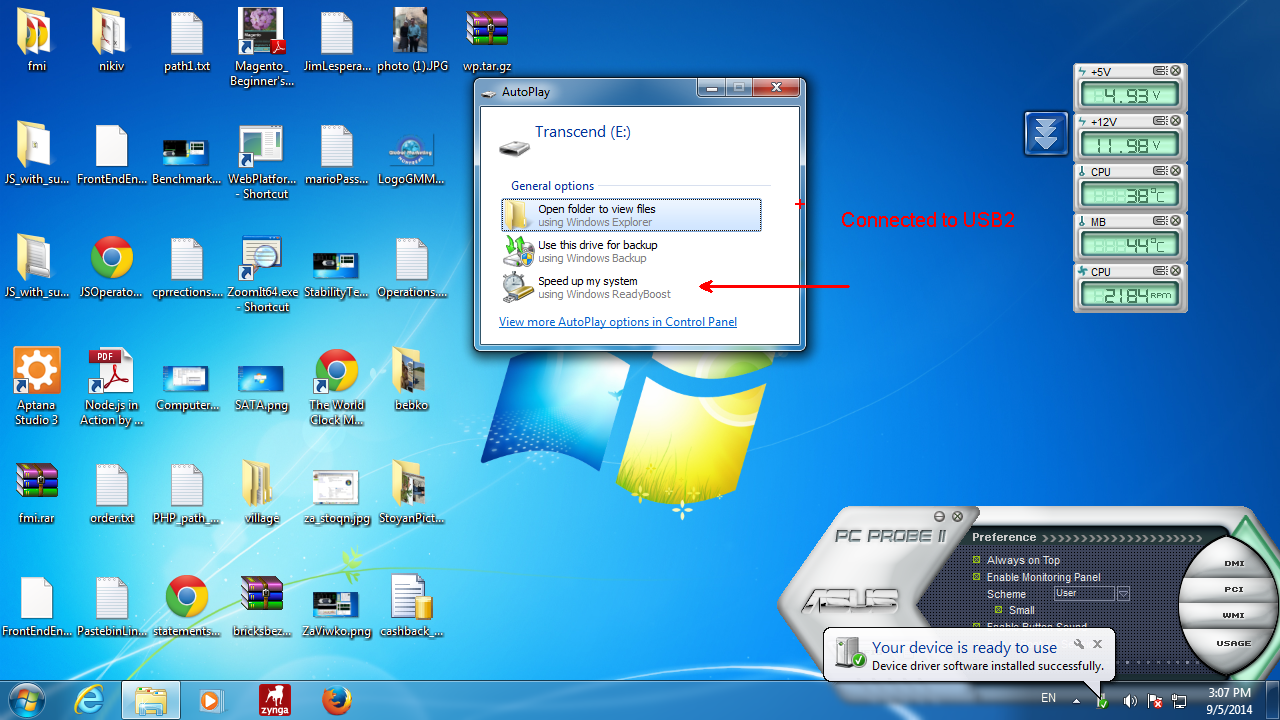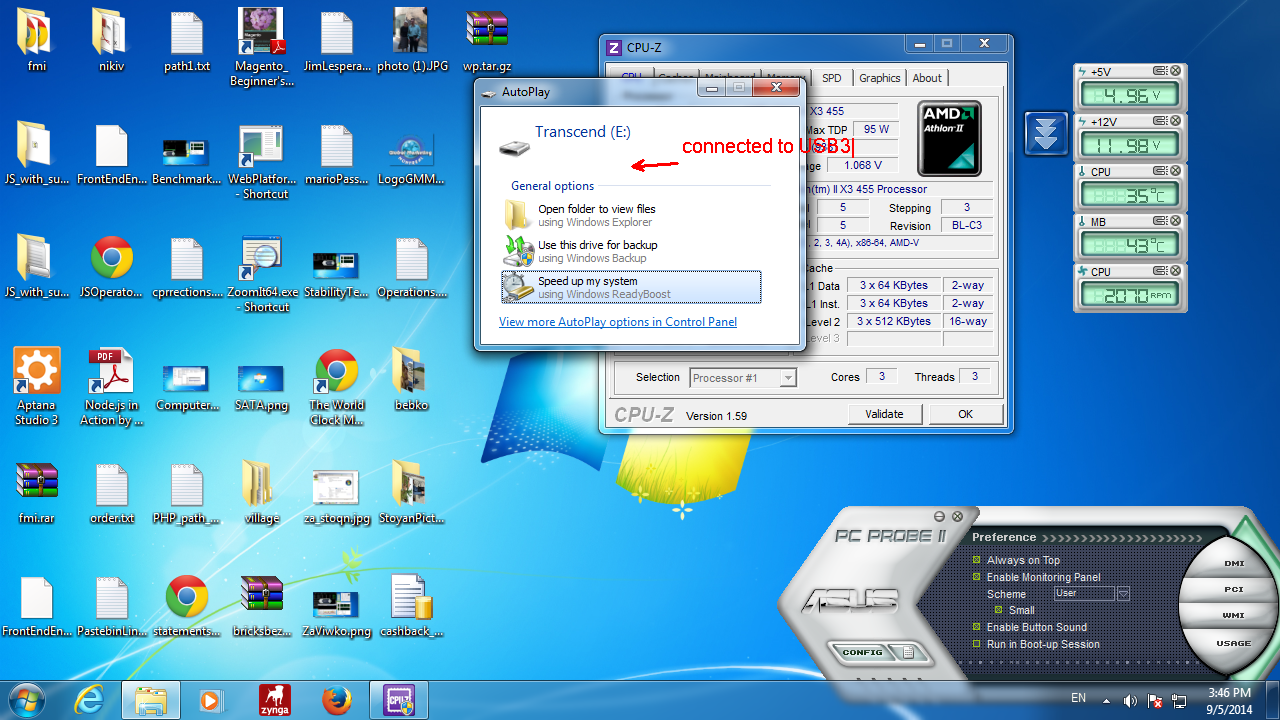Intel Thunderbolt, as per the Wikipedia Sata link just above, is 10GB/s
Also, none of these answers so far give any practical/useful information. Theoretical maximum and real-world speeds can vary wildly, and only some significant actual testing will give meaningful answers.
So far, I haven't found many such tests. There's one at Crunchgear.com:
But even this leaves some question, as perhaps their specific USB 3.0 implementation is not optimal. (we need more variety to be sure, and even then, your system (or any given system) may not produce comparable benchmarks)
Another seems to suggest USB 3.0 "Turbo" (whatever that is?) has a bit over eSATA, at sansdigital.com:
But I have to question that, suggesting ~200 MB/s hard drive read/write speeds - unless hard drives have dramatically improved recently, I don't believe those speeds are physically possible, and suspect those speeds are just cached.
It's probably relatively safe to go with eSATA or USB 3.0 and get speeds that are close to optimal... as long as there's nothing choking your chain, so to speak. (poorly designed or cheap component, etc., causing a bottleneck) We really need more real world comparisons with various different hardware components.
http://techcrunch.com/2010/02/05/esata-is-faster-than-usb-3-0-at-least-right-now/
Testing parameters: These numbers were gathered using HD Tune Pro 4.01. I also timed an 8.34 GB file transfer onto the drive for real world results. The two external drives were 7200 RPM models, while the internal was a 5400 RPM drive. I would have liked to show the Western Digital MyBook 3.0’s results as well, but the drive and HD Tune Pro didn’t get along. Check out the review for a comparison between the SeagatePS110 — it’s just slightly faster.
But if you’re looking for a reliable and fast external hard drive right now, forget USB 3.0 and instead look at eSATA drives.
-------------------------------------------------------------------------------------------------
sms.bg
My Tests on computer Ani
On the ns2
Ina comp
ns2 with USB3 JetFlash Transcend but connected to USB2
OPEN CASE. The temp was very high before.
THE REASIN IS NOT WORKING FAN ON THE POWER SUPLY!!!!
When you touch it with hand you can feel it hot.
Connected to USB3 on ns2
again test on ns2 with open case
ns2 open case Transcent Read Boost Enabled
Ani comp USB3 Transcend 32GB connected to USB2 front panel
Canada RAID
The very same USB2 JetFlash Transcend 32GB za 30BGN on the Ina computer
The very same USB 2 Flash Kingston 4GB password on the Ina comp
The very same USB2 JetFlash Transcend 32GB for 30BGN on ns2 comp
The speed of the computer is also very important. USB goes trough the CPU.
The very same USB3 JetFlash Transcend 32GB for 30BGN attached to USB2 port on Ina comp after adding 4 Live Linux distributions
The very same USB3 JetFlash Transcend 32GB for 30BGN attached to USB2 port on the fastest ns2 comp after adding 4 Live Linux distributions
The very same USB3 JetFlash Transcend 32GB for 30BGN attached to USB3 port on the fastest ns2 comp after adding 4 Live Linux distributions
The speed of the USB device depends on the computer also. The very same Corsar but with slower Ina computer. The speed is ~20MB/s now:
USB 1.1 = 12 Mbit/s
FireWire 400 = 400 Mbit/s
USB 2.0 = 480 Mbit/s
FireWire 800 = 800 Mbit/s
USB 3.0 = 5 Gbit/s
eSATA = Up to 6 Gbit/s right now as it depend on the internal SATA chip.
Ani comp
SATA 2 old HDD - 76.1 MB/s - 40C
SATA 3 1TB brind new - 167.1 - 36C
USB 2 Flash Kingston 4GB password - 14.9
USB 2 Flash Corsar 16GB - 28.3
USB 2 Maxell 4GB - 11.9
USB 2 Flash Kingston 8GB - 20.0 - 41C
USB 2 Flash Kingston 32GB - 20.1
USB 2 1TB Seagate Free Agent external HDD - 29.4 - 26C
USB2 JetFlash Transcend 32GB za 30BGN - 29.7
ns2
SATA 3 1TB brind new - 158.6 - 49C
SATA 3 1TB old one for the Datacenter formatted partitioned - 98.3 - 50C
USB2 JetFlash Transcend 32GB za 30BGN read Boost disabled - 26.7
USB3 JetFlash Transcend 32GB za 30BGN Read Boost disabled - 80.7
USB3 JetFlash Transcend 32GB za 30BGN Read Boost enabled - 80.7
Ina
SATA 2 Ina 80GB - 49.8 - 44C
USB2 JetFlash Transcend 32GB za 30BGN read Boost disabled - 17.3
USB 2 Flash Kingston 4GB password - 11.3
Canada RAID
2 Seagate Baracuda 120Gb HDDs fake RAID - 44.6
USB 1.1 = 12 Mbit/s => 12*1024*1024/(8*1024*1024) = 12/8 = 1.5MB/s
or 12*1000*1000/(8*1024*1024) = 1.430511474609375 MB/s
FireWire 400 = 400 Mbit/s => 400/8 = 50MB/s
USB 2.0 = 480 Mbit/s => 480/8=60MB/s
FireWire 800 = 800 Mbit/s => 800/8=100MB/s
USB 3.0 = 5 Gbit/s => 5/8 = 0.625 GB/s
eSATA = Up to 6 Gbit/s right now as it depend on the internal SATA chip. => 6/8 = 0.75GB/s
Conclusion:
1) The ordinary USB2 flash drives have read speed of ~20MB/s
2) Special and more expensive USB2 flash drive models Corsar and USB2 external HDD. Also the Ordinary USB3 Flash drives connected to USB2 ports ~30MB/s
3) Internal SATA drives ~ 160 MB/s
The best is to buy a cheap USB3 Flash Drive. Even connected to USB2 port the performance still will be around 30MB/s
*Computers used for the tests:
Ina:
ns2

































































































































